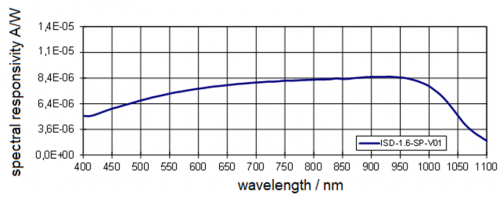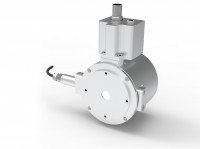This product is no longer manufactured. Remaining stock may still be available. Please refer to the alternatives listed below under "Similar products" or contact us directly.
Alternative Products for this discontinued product:
ISD-1.6-SP-Vxx
Detector for fast, time-resolved (ns) radiant power measurement of pulsed laser diodes and LEDs
- Integrating sphere for measurement of laser power and pulse shape
- Ideal for Beam Profile Laser, Mode Laser or LiDAR Laser Characterization
- Pulse waveform with peak power and pulse energy (in joules) of pulses with pulse lengths in the low ns range
- Optional 7 mm measuring aperture for eye safety according to IEC/EN 60825-1 and 2006/25/EC (Safety of laser products - Part 1: Equipment classification and requirements)

Pulsed laser diodes, LiDAR laser, VCSEL and pulsed LEDs used in range finders, environmental scanners and image capture emit pulses with a few nanoseconds length of very high peak power. To measure the temporally resolved pulse shape fast detectors (short rise time) are required. These are usually small-area photodiodes with diameters of sometimes significantly less than 1 mm. Technical details regarding rise time and pulse shape measurements with photodiodes can be found for example in our knowledge portal. The small detector area of the photodiodes results in metrological limitations:
- The extent of the laser spot is larger than the active area of the photodiode and thus does not allow measurement of the radiant power (W). Thus, no measurement of the radiant power (W) is possible with such a photodiode alone.
- The position of the photodiode in the laser spot is critical because of possible modes (inhomogeneous laser spot).
- Very small photodiodes cannot be calibrated absolutely.
- Attachment optics used to focus the laser spot on the photodiode surface cannot be calibrated.
- The electronic wiring of the photodiodes required for short pulse lengths further limits the calibration capability.
With the ISD-xx-SP-series of detectors in combination with the P-9710 series or P-21 series optometers (current amplifier), Gigahertz-Optik provides a way to determine the absolute peak performance of pulsed lasers and pulsed LEDs.
To overcome the limitations of pure photodiodes, a technology based on a small integrating sphere and two complementary photodiodes is used.
Function and structure
The detector incorporates two photodiodes within a compact integrating sphere assembly. The first photodiode has a short rise time and hence, in conjunction with a sufficiently fast oscilloscope, allows the measurement of the relative time resolved pulse shape (pulse length, half-width, peak power). The second photodiode measures the absolute pulse energy (in joules) of a single pulse or pulse train. The evaluation is carried out by an optometer of the P-9710 or P-21 series according to the pulse-stretching method. The absolute peak power can be calculated from the pulse energy and the relative pulse shape. Thus, the short duration light signal can be completely characterized.
The integrating sphere with a diameter of 16 mm offers a measuring aperture of 5 mm, alternatively 7 mm (Eye-Safety for Laser according to IEC/EN 60825-1 and 2006/25/EC), diameter and can be calibrated to measure the absolute radiant power (W). Because of the very small diameter of the integrating sphere, the temporal pulse deformations (pulse-stretching-effect of integrating spheres) are small compared to integrating spheres with larger diameters. As a result, pulses of a few nanoseconds pulse length are hardly deformed and can be measured in a time-resolved manner. The sphere itself, the photodiodes and the electrical circuit are housed and shielded by a high quality CNC-machined aluminium housing. For higher power and a larger input port with 10 mm we offer the ISD-5P-SP or with 20 mm input port the ISD-10P-SP.
The optional oscilloscope is connected via a BNC connector. The optometer is connected via a 2 m cable with a multi-pin connector in which the calibration data are stored.
The integrating sphere also offers two SMA-fiber connectors. For example, a spectrometer for measuring the wavelength and an auxiliary lamp for compensating for possible influences of the back reflection through the sample at the measurement port(self-absorption correction) can be connected. Ideal suited could be also one of our BTS2048 Series high end spectroradiometer.
Because of its small diameter, the sphere factor of the integrating sphere is relatively small. As a result, the permissible beam divergence in the version with a 7 mm measuring opening is additionally limited compared to the 5 mm version.
Two-Diode-Technology
High speed integrating spheres which are equipped with Gigahertz-Optik’s two-diode technology offer two photodiodes mounted on the sphere. A traceable calibrated photodiode is accurately measuring the total pulse energy. The second photodiode is performing a temporal characterization of the pulse and will deliver its relative pulse shape as result. With both results combined mathematically, the pulse can be completely characterized regarding all important parameters (pulse form, peak power, average power).
Evaluation
Gigahertz-Optik offers various optometers with the required "pulse energy" measurement function for measuring the pulse energy of short pulse signals:
P-9710 (Version-2): Single-channel optometer with manual triggering of the measurement
P-9710 (Version-4): Single-channel optometer with TTL trigger input for triggering the measurement
P-2000: two-channel optometer
P-9801: Eight-channel optometer
P-21: Touchscreen Single-channel optomter with manual or trigger input for triggering the measurement
To evaluate the time resolved pulse shape, the user must provide a sufficiently fast oscilloscope.
Calibration
The factory calibration of the spectral sensitivity of the pulse Energy detector is performed by the ISO/IEC 17025 calibration laboratory for optical radiation measurements at Gigahertz Optik GmbH. The principle of the pulse-stretch-method allows the calibration of the detector in CW operation. The CW-calibration is fully traceable.
Applications
The application areas of the detector can be found, for example, in the development and quality assurance (on- and in-line) of pulsed laser diodes, LiDAR laser, VCSEL and pulsed LEDs as well as in the end application of such light sources.

Figure 1: ISD-1.6-SP-V02 detector with single channel optometer P-9710-2

Figure 2: System illustration, oscilloscope, P-9710-2, ISD-1.6-SP-V02

Figure 3: Schematic representation (1: integrating sphere 2: measuring aperture 3: spherical surface of the first reflection 4: pulse energy photodiode 5: pulse progression photodiode 6: 2 x SMA connectors 7: cable for optometer 8: female BNC connector oscilloscope 9: bias voltage)

Figure 4: Schematic measuring arrangement (1: ISD-1.6-SP-Vxx 2: oscilloscope 3: P-9710-4 4: bias voltage 5: TTL signal trigger Input

Picture 5: Typical spectral sensitivity
Similar Products


Product Categories